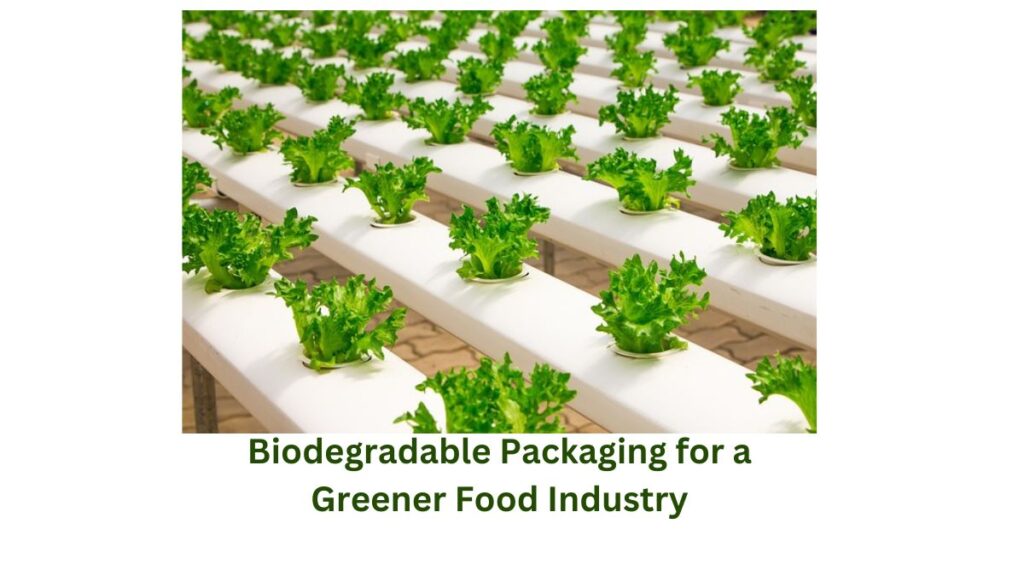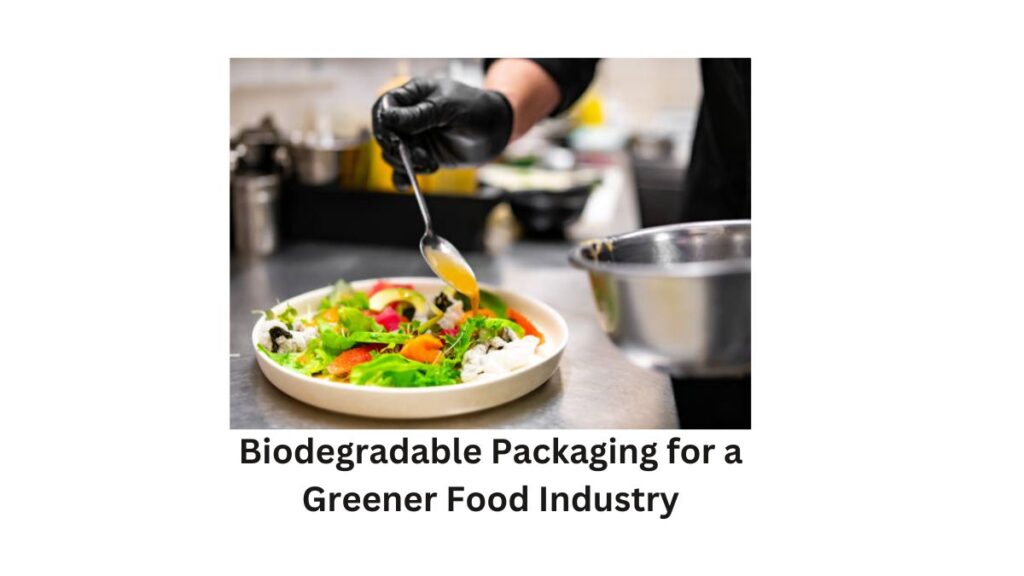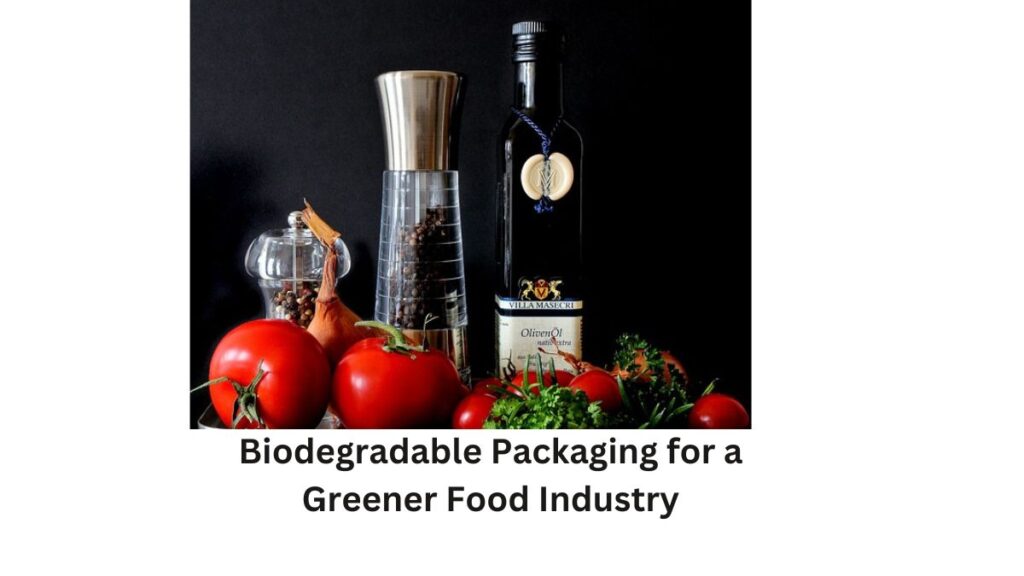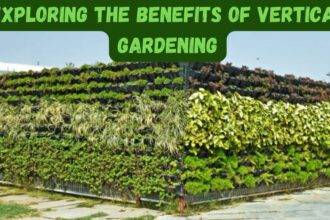Introduction:
Eco-Friendly Revolution:Biodegradable Packaging for a Greener Food Industry

In an era where environmental consciousness is paramount, the food industry is making strides towards a greener future. This article explores the transformative impact of biodegradable packaging on the sustainability landscape, shedding light on the sustainable choices that are reshaping the way we package our food.
Discuss the urgency for the greener food industry to adopt more sustainable alternatives?
Plastic Pollution Pervasiveness

The ubiquitous use of conventional packaging materials, particularly plastics, has inadvertently led to a surge in environmental degradation. Plastic pollution has become a pressing concern, with vast quantities of non-biodegradable packaging ending up in landfills and oceans. As plastics break down into microplastics, their harmful impact on ecosystems and marine life intensifies.
Non-Biodegradable Waste Crisis
The food industry’s reliance on non-biodegradable packaging exacerbates the global waste crisis. Landfills are inundated with packaging materials that take centuries to decompose, contributing to soil contamination and compromising the health of our planet. The urgency to address this crisis has never been more apparent.
Traditional packaging methods significantly contribute to greenhouse gas emissions and climate change. The extraction, production, and disposal of non-biodegradable materials release harmful gases, further intensifying the environmental challenges we face. The need for a sustainable shift is not just a choice; it is an essential step in mitigating the impact of climate change.
Consumer Demand for Responsibility
Consumers are increasingly prioritizing environmentally conscious choices. As awareness grows, so does the demand for sustainable practices in the food industry. Brands that fail to adapt risk losing market share and facing reputational damage. The need for change is not only an environmental imperative but a strategic business decision.
The Call to Action
The urgency for change is clear. Traditional packaging methods are no longer tenable in the face of escalating environmental issues. The food industry must heed the call to action and transition towards sustainable alternatives. In the following sections, we explore the promising realm of biodegradable packaging and its potential to revolutionize the way we approach packaging, offering a beacon of hope for a greener, more sustainable future.
Explain what biodegradable packaging is and how it differs from conventional packaging?
Demystifying Biodegradable Packaging
Biodegradable packaging refers to materials that can naturally decompose over time, breaking down into simpler, environmentally benign substances. Unlike traditional packaging, which can persist in the environment for centuries, biodegradable materials undergo a natural degradation process, leaving behind minimal ecological impact.
How it Differs from Conventional Packaging
The key differentiator lies in the materials used. While conventional packaging, often derived from non-renewable resources like plastics, remains resistant to decomposition, biodegradable packaging utilizes organic and renewable materials. This fundamental shift in composition ensures that, when discarded, these materials return to the natural environment without leaving a lasting footprint.
Materials Used in Biodegradable Packaging
Plant-Based Bioplastics
Biodegradable packaging commonly incorporates bioplastics derived from renewable resources such as cornstarch, sugarcane, or potato starch. These plant-based materials mimic the functionality of traditional plastics without the long-lasting environmental consequences.
Compostable Materials
Compostable packaging goes a step further, breaking down into nutrient-rich compost when subjected to specific conditions. Materials like PLA (Polylactic Acid) and PHA (Polyhydroxyalkanoates) fall into this category, offering a circular approach to waste management.
Eco-Friendly Attributes
Reduced Carbon Footprint
Biodegradable packaging materials generally have a lower carbon footprint compared to their conventional counterparts. The production of these materials often involves fewer greenhouse gas emissions, contributing to overall environmental sustainability.
Soil Enrichment
As biodegradable materials decompose, they release valuable nutrients into the soil, enhancing its fertility. This contrasts sharply with the soil pollution caused by non-biodegradable materials, providing a regenerative aspect to the packaging lifecycle.
Positive Impact on the Environment
Preserving Ecosystems
Biodegradable packaging plays a crucial role in preserving ecosystems by minimizing the long-term environmental impact associated with traditional packaging methods. It aligns with the principles of a circular economy, where waste is transformed into a resource.
Sustainable Resource Management
By utilizing renewable resources, biodegradable packaging supports sustainable resource management, reducing dependence on finite fossil fuels. This shift fosters a more balanced and resilient approach to meeting packaging needs.
Emphasizing the Green Future
Understanding biodegradable packaging unveils a path towards a more sustainable and eco-friendly future. In the subsequent sections, we explore the positive impact of adopting these materials in the food industry, showcasing how such choices can contribute to a greener and more responsible approach to packaging.
Detail the advantages of incorporating biodegradable packaging in the Greener food industry?
Aligning with Consumer Preferences

Environmental Consciousness
Consumers today are increasingly environmentally conscious, seeking products and brands that align with their values. By adopting biodegradable packaging, the food industry demonstrates a commitment to sustainability, resonating with a growing market segment that prioritizes eco-friendly choices.
Ethical Consumerism
Biodegradable packaging appeals to the ethical consumer, who seeks products that minimize environmental impact. This alignment fosters a sense of trust and loyalty, as consumers appreciate brands that actively contribute to mitigating ecological challenges.
Enhancing Brand Image
Differentiation in the Market
The adoption of biodegradable packaging sets food brands apart in a competitive market. It becomes a unique selling point, showcasing a brand’s dedication to responsible business practices. This differentiation not only attracts environmentally conscious consumers but also positions the brand as an industry leader in sustainability.
Positive Public Perception
Public perception plays a pivotal role in brand success. Embracing biodegradable packaging generates positive publicity, enhancing a brand’s reputation as socially responsible. This positive image resonates with consumers, influencing their purchasing decisions and fostering brand loyalty.
Discuss how it aligns with consumer preferences, enhances brand image, and contributes to a healthier planet.
Contributing to a Healthier Planet
Reducing Plastic Pollution
One of the primary environmental benefits of biodegradable packaging is the reduction of plastic pollution. As these materials break down naturally, they leave behind minimal traces, alleviating the burden on landfills and oceans caused by non-biodegradable packaging.
Lowering Carbon Footprint
The production of biodegradable materials often involves fewer emissions compared to traditional packaging. This contributes to an overall reduction in the food industry’s carbon footprint, supporting global efforts to combat climate change.
Economic Advantages
Cost-Efficiency in the Long Run
While the initial investment in biodegradable packaging might be marginally higher, the long-term cost-efficiency becomes evident. Reduced environmental impact may lead to regulatory and tax incentives, and the positive brand image can translate into increased customer loyalty and market share.
Adapting to Changing Regulations
Anticipating and adapting to evolving environmental regulations positions food industry players ahead of potential legal challenges. Embracing biodegradable packaging ensures compliance with emerging sustainability standards, safeguarding against regulatory risks.
Conclusion:
Summarize the key takeaways, emphasizing the role of biodegradable packaging in creating a greener and more sustainable future for the food industry. Encourage businesses to consider the positive impact they can make by adopting eco-friendly packaging solutions.
Remember to incorporate relevant keywords throughout the article to enhance its SEO friendliness, such as “biodegradable packaging,” “sustainable food industry,” and “eco-friendly choices.”





